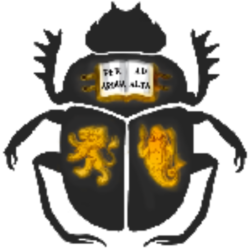“Would I lie to you?”
The Truth Behind Object Marks and Museum Catalogue Entries
Carla Gallorini
In 1914, having finished work at Abydos, G.A. Wainwright and T. Whittemore turned their attention to the cemeteries close to the village of Sawâma, located on the eastern bank of the Nile, near the modern village of As Sawamah Sharq and roughly 10 kilometres north of Akhmim. The work was carried out on behalf of the American branch of the Egypt Exploration Society (then Fund) in the hope that the site “might still yield types of pottery much sought by the museums, and, perhaps, other objects of interest”.[1] During their work at Sawâma Wainwright and Whittemore investigated various cemeteries, mostly datable to the New Kingdom (1550-1069 BC), but in the preliminary report Whittemore also recorded the presence of Roman tombs and a Coptic cemetery (30 BC-639 AD).[2] However, the site is usually associated with an early Eighteenth Dynasty (1550-1400 BC) cemetery which produced an abundance of material scattered today amongst various American Museums[3]. A full report of the excavation at Sawâma never appeared[4], but in 1971 Bourriau and Millard published a detailed account of Wainwright and Whittemore’s work based on the original excavation records and on the examination of many of the objects in American museums.
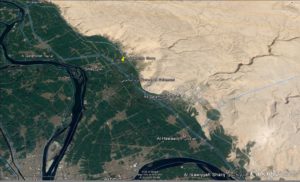 |
Among the objects on loan to the University of Birmingham from the Eton Myers collection is an assorted group of pottery vessels presented to Eton by G.A. Wainwright in 1959. The vessels are listed in the museum catalogue as coming from Sawâma, although in three cases[5] the provenance is queried with a question mark. The aim of this short paper is to look more closely at the vessels and the objects marks they bear in relation to the original excavation records[6] in the hope they could provide evidence to validate or refute the suggested provenance.
The group consists of five vessels, one complete[7], two fragmentary[8] – but enough of the body is preserved to allow for a secure attribution to their ceramic type – and two small rim sherds[9].
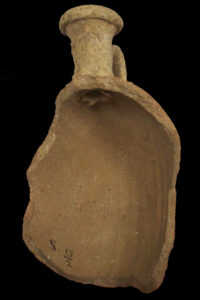 © Eton Myers Collection, University of Birmingham |
There is no doubt that ‘pilgrim flask’ ECM 1981 comes from the early Eighteenth Dynasty cemetery at Sawâma. Object mark ‘S.15/2’ is easily deciphered: ‘S.’ stands for Sawâma, ‘15’ refers to the number given to the grave in which the vessel was found – Grave 15 – and ‘2’ signifies that two vessels of this type were retrieved.
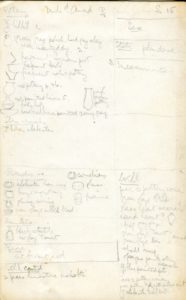 Courtesy of the Egypt Exploration Society |
The original excavation records strongly support this interpretation. Each tomb card from Sawâma bears the tomb number on the top right-end corner usually in the form of ‘S. x’, just like the object mark on our flask; in the tomb card for Grave 15, beside the sketch of the pilgrim flask are the words ‘green grey polish. Hard grey clay. Neck inserted dry. 2’; very similar wordings are also found on the pottery drawing sheet, where the presence of two examples of this pottery type in Grave 15 is expressed in the same way, as a fraction, with 15 over 2. It is also interesting to note the comment ‘neck inserted dry’, suggesting that our flask was found already broken, as the manufacturing technique cannot be detected by looking at a complete vessel. From the same grave and now housed in the University Museum, Philadelphia, is a Cypriote base-ring ware juglet, a type also known as bilbil (accession number E15445.) The juglet has an almost identical object mark ‘S.15/1’, and from the excavation tomb card we know it was found in the same grave as our pilgrim flask. The marks must have been applied to the vessels before the final distribution between museums took place.
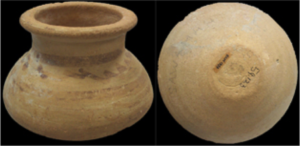 © Eton Myers Collection, University of Birmingham |
ECM 1957 is a small squat jar in Marl A2 with decoration in red still visible on the neck and shoulder. On the base, the word ‘SAWAMAH’ is written in pencil and is accompanied by previous and current accession numbers – ‘59.128’ and ‘ECM 1957’ – in ink. The general pottery type is well attested at Sawâma, in a range of sizes and with or without decoration.[10] On the basis of the size, of the overall shape and of the small flat base, our vessel belongs to type 82 in the Sawâma corpus,[11] although the decoration does not match the one illustrated in the pottery plates. This is not surprising as it was general practice at the time to draw only one vessel of the many found, and then add notes concerning the surface treatment of the other examples to the side of the drawing. Only one of the five examples[12] of type 82 known to have come from Sawâma has been positively identified[13], but the description of the remaining vessels in the original records is too vague to allow the attribution of our jar to any of the tombs listed in the pottery plates.
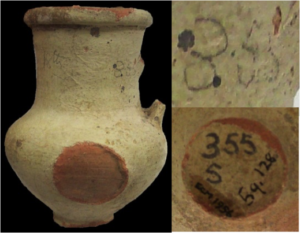 © Eton Myers Collection, University of Birmingham |
ECM 1956 was originally part of a double vase, consisting of a jug and a pilgrim flask thrown separately but then joined together through a loop at the rim.[14] The damage on our jug shows clearly where it was once attached to the pilgrim flask, both at the rim and on the body. On the neck of our jug are two marks in pencil: ‘18th’ and ‘355’. In the past mark ‘355’ has been read as ‘85 S’, due to scratchings and stains on the surface, and it is listed as such in the museum catalogue, suggesting a provenance from grave 85[15] at Sawâma. However close inspection of the piece has made clear that the correct reading is ‘355’ (Fig. 5). The latter is also repeated in ink on the base, accompanied by number ‘5’ and by the previous and current accession numbers – ‘59.128’ and ‘ECM1956’. The single ‘5’ on the base has been read in the past as ‘S’ and it is listed as such in the museum catalogue, maintaining the perception that the vessel was found at Sawâma. Following the new reading, the marks in pencil refer respectively to the probable date for the vessel – Eighteenth Dynasty – and the tomb number in which the vessel was found (355). Wainwright used a similar marking system in pencil on the pottery from Balabish[16] and some of the marks must have been applied at the time of the excavation as they are already visible in the original half-plate negatives[17]. Only 161 graves were cleared at the early Eighteenth Dynasty cemetery at Sawâma, undermining a possible provenance of ECM 1956 from this cemetery. Furthermore, this type of jug, either on its own or as a part of a double vase, is not present in the known corpus of pottery from the site and double vases of this type are more commonly found in contexts later in date, form the reign of Amenhotep III to the early Nineteenth Dynasty (1390-1240 BC). It is clear that the association between Sawâma and ECM 1956 is based on a misinterpretation of the object marks and should therefore be rejected.
 © Eton Myers Collection, University of Birmingham |
ECM 1963 and ECM 1965 are two small rim sherds from ‘White Crossed-Line’ ware (C-ware) vessels, most likely a bowl and a beaker. Both sherds are in fabric Nile A, red coated on the exterior and inside the rim, and burnished. Linear decoration is applied on the exterior in white gypsum paint. Both sherds bear on the interior the object marks ‘S’ and ‘WAIN. 16’ in ink, while only ECM 1963 also has the mark ‘N+B’ in pencil. The ‘S’ could be a reference to Sawâma while ‘WAIN. 16’ is more difficult to interpret. It also appears on two further C-ware sherds[18] of unknown provenance, hinting at a possible use of the mark within Wainwright’s own pottery typology. The mark ‘N+B’ has no parallel among the other Wainwright’s objects here in Birmingham, and I tentatively suggest a reference to Petrie’s publication Nagada and Ballas, in which this kind of Predynastic pottery was first described[19]. C-ware is mostly found in funerary contexts dated mostly to the Naqada I Period (c. 4000-3500 BC). Its spatial distribution is limited to the area between Matmar and Hierakonpolis, with a small pocket in the Aswan region.[20] There is no mention in the published or unpublished records from Sawâma that Wainwright and Whittemore ever investigated a Predynastic cemetery or that Predynastic sherds were found among the pottery in the early Eighteenth Dynasty graves[21], but the provenance from Sawâma cannot be completely ruled out. The object mark ‘S’, so similar to the one on ECM 1981, supports the attribution, as does Sawâma geographical position, just to the south of one of the three main areas in which C-ware flourished: on the east side of the Nile between Matmar and Hemamieh.[22] We have to allow for the possibility that our sherds were surface finds kept by Wainwright for its own reference collection.
One of the obvious and lasting consequences of the ‘partage’ system[23] is the dispersal of artefacts from excavations to institutions and private collections worldwide. The vessels discussed above illustrate clearly the difficulties faced when trying to recreate the severed link between museum objects and their original archaeological contexts.
[expand title=”Endnotes”]
[1] Whittemore’s foreword to Wainwright 1920: v
[2] Whittemore 1914: 246
[3] The finds from the excavation were divided between the Egyptian Museum in Cairo, The Brooklyn Museum, Cornell University, the University Museum in Philadelphia, and the Oriental Institute of the University of Chicago (Bourriau and Millard 1971: 28; Artefacts of Excavation – British Excavations in Egypt 1880-1980).
[4] Whittemore published a brief report in JEA 1, 1914, 246-7 and made passing references to some of the finds from Sawâma in his foreword to Wainwright’s publication of Balabish (Wainwright 1920: v-vi).
[5] ECM1956, ECM1963 and ECM1965.
[6] The records – housed in the Lucy Gura Archive, The Egypt Exploration Society, London – consist of tomb cards, drawings of pottery, stone vessels, scarabs and beads, 77 half-plate negatives and a notebook listing the photographs. Tomb cards and negatives are readily available on the Society’s Flickr feed. I would like to thank Carl Graves for his help in accessing the material in the Society’s London office.
[7] ECM1957.
[8] ECM1981 and 1956.
[9] ECM1963 and ECM1965.
[10] Bourriau and Millard 1971: fig. 5, 69-77 and fig. 6, 78-89
[11] Bourriau and Millard 1971: fig. 6
[12] From graves S2, S11, S41, S73 and S99.
[13] Bourriau and Millard 1971: 38; The jar from grave S11. It is kept in the Brooklyn Museum, accession number 14.635, and according to the original records is the only one with decoration also on the rim.
[14] Gallorini 2013; for a complete example see E.2610
[15] Tomb 85 at Sawâma produced three vessels: type 20, 22 and 38 (Bourriau and Millard 1971: fig. 15).
[16] Compare C. Graves 2016 in this exhibition.
[17] See for example the fragmentary vessel in the shape of a bird from tomb 66 at Balabish (Wainwright 1920: plate XXV, 56; Egypt Exploration Society’s Flickr feed, Balabish Negatives 1915, BAL.NEG.78).
[18] Also presented to Eton by Wainwright: ECM1964 and ECM1966.
[19] Wainwright used the abbreviation N.B. in reference to Petrie’s publication in the footnotes of his Balabish volume.
[20] Graff 2011: 49, fig. 1
[21] As it happened for example in a Pan Grave tomb at Balabish (Wainwright 1920: 41, pl. I, 2, tomb group 208).
[22] Finkenstaedt 1981: 7
[23] The practice of distributing finds from excavations to public institutions or private individuals who had sponsored the work (Stevenson, Libonati and Williams 2016).
[/expand]
[expand title=”Bibliography and Further Reading”]
Bourriau, J. and Millard, A. 1971. ‘The excavation of Sawâma in 1914 by G.A. Wainwright and T. Whittemore’, Journal of Egyptian Archaeology 57, 28-57.
Finkenstaedt, E. 1981. ‘The Location of Styles in Painting: White Cross-Lined Ware at Nagada’, Journal of the American Research Center in Egypt 18, 7-10.
Gallorini, C. 2012. ‘Innovation through Interactions: A Tale of Three ‘Pilgrim Flasks’’, in C. Graves and S. Gregory (eds.), Connections: Communication in Ancient Egypt, University of Birmingham http://www.birmingham.ac.uk/research/activity/connections/Essays/CGallorini.aspx
Graff, G. 2011. ‘Les enjeux de l’iconographie des vases peints de Nagada II (Égypte, IVe millénaire): maintien de l’équilibre cosmique ou régénération de la vie?’, Anthropozoologica 46 (1), 47-64.
www.academia.edu/792991/les_enjeux_de_l_iconographie_des_vases_peints_de_nagada_ii_E_gypte_iv_e_mille_naire_maintien_de_l_e_quilibre_cosmique_ou_re_ge_ne_ration_de_la_vie_
Graves, C. 2016. “Balabish: rediscovering an expedition”, in S. Boonstra (ed.) Objects Come to Life, Birmingham Egyptology.
https://more.bham.ac.uk/birminghamegyptology//virtual-museum/objects-come-to-life/balabish/
Stevenson, A., Libonati, E., and Williams, A. 2016. ‘A selection of minor antiquities: a multi-sited view on collections from excavations in Egypt’, World Archaeology 48 (2), 1-14
www.tandfonline.com/doi/full/10.1080/00438243.2016.1165627
Wainwright, G.A. 1920. Balabish. London.
https://archive.org/details/balabish37wain
Whittemore, T. 1914. ‘The Sawâma cemeteries’, Journal of Egyptian Archaeology 1 (4), 246-247.
[/expand]
